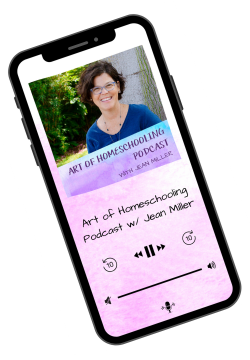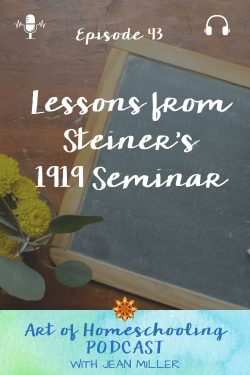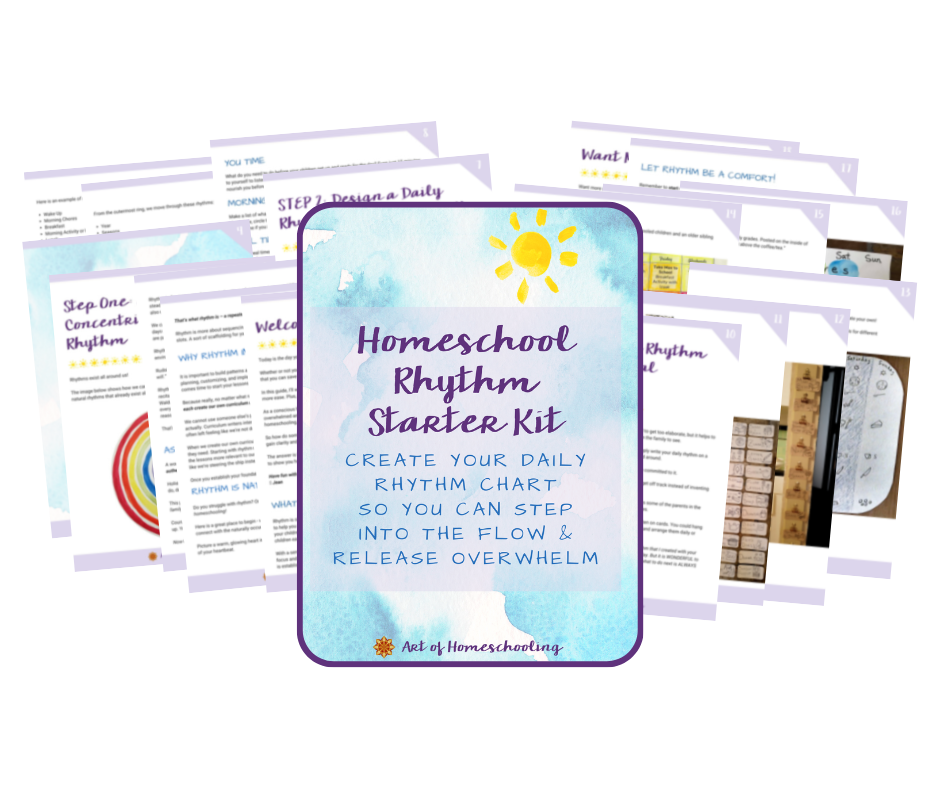Episode 43
Welcome to Episode 43 of the Art of Homeschooling podcast! Today, we’re talking about the top 10 lessons from Steiner’s 1919 Seminar Course for the first Waldorf teachers and applying them to homeschooling,
Rudolf Steiner, the founder of Waldorf education, presented his Seminar Course to a small group of 12 teachers before the opening of the very first Waldorf school in Stuttgart, Germany. In the spring of 1919, Emil Mott, the owner of the Waldorf-Astoria Cigarette Factory, asked Steiner to start a school for the children of his factory workers. Steiner hoped to bring about social and economic renewal in post-WWI Germany through education.
So, in late summer, 1919, Steiner gathered twelve individuals, most of whom had not been teachers by trade up to this point. And he presented 14 days of lectures to train the teachers in preparation for the opening of the school. The Foundations lectures were given in the morning each day. The Practical Advice lectures came in the late morning/early afternoon. And then Discussions took place in the late afternoon.
Check out the resources below for links to these lectures!
Lessons from Steiner’s 1919 Seminar
It’s now August as I’m recording this episode, and I always feel a particular connection to, even a kinship with, these first teachers every summer at this time!
I’ve had a fascination with the Seminar Course for years because it’s really the first Waldorf teacher training. Many Waldorf classroom teachers read these lectures in preparation for teaching. I’ve read them with an eye toward both education in general and homeschooling in particular. And what I’ve discovered is that there’s so much more freedom in going back to the source rather than trying to emulate a classroom at home.
I truly believe what longtime Waldorf teacher Stephen Sagarin says here:
“What Steiner had to say leaves open many more possibilities than are available in practice today.”
TOP 10 LESSONS FROM STEINER’S 1919 SEMINAR COURSE
#1: Preparation Can be Brief
The Seminar Course lectures were given over just two weeks!
One of the most fascinating aspects of this Seminar Course is that it lasted only 14 days, from August 21st to September 6th. Then the the very first Waldorf School opened the next day! In this relatively short time, Steiner spoke on his philosophy of education, gave specific indications for specific subjects, and addressed the questions of the soon-to-be teachers. All of this in just two intense weeks of gathering the new teachers together!
The first lesson: Study, make reasonable preparations, then begin, adjusting as you go.
I think many of us Waldorf-inspired homeschoolers get hung up in the early stages, trying to figure it all out and wanting to “have it right” before we even begin. Just jump in!
#2: The Purpose of Teaching & Curriculum is Balance & Integration of our Full Humanity
“Teachers must ask themselves what natural talents are hidden in every person and what they must bring out in each child so that the pupil may finally realize his own humanity in balanced integration. Whether the child will one day be a doctor or a ship-builder need not concern the pedagogue who teaches him at the age of six. The teacher’s task is to make him into a full human being.” ~Rudolf Steiner
The second lesson: We each create our own Curriculum – because teaching is an art.
Even if you choose to purchase a “complete curriculum package,” that really becomes just a jumping off point. You will still, by necessity, make changes suited to your child or children. Also keep in mind that the Waldorf curriculum has such a great deal of material in it that even the first teachers in the first year could not get it all in! Teachers sometimes had to forego some lessons or subjects for others . So, pick what speaks to you, what moves you and teach from that place!
#3: There was Compromise from the Beginning
The third lesson: Flexibility and compromise are required from day one!
There is no perfect way. And there is no perfect Waldorf school or homeschool. Steiner even suggested that we start with the ideal in mind, and make compromises from there based on our circumstances.
#4: Stories and History Form the Foundation of the Curriculum Including Geography
The fourth lesson: Do not explain the stories, but tell or read them in order to move the whole child’s being.
“Communication must be from soul to soul.” As homeschoolers, I think we are in a great position to strive for this description of Steiner’s: “Let your influence arise out of your close intimacy with the children…not through artificial sensationalism.” ~Rudolf Steiner
#5: Block Teaching & Main Lesson Books Make for Efficient Teaching
The fifth lesson: Create main lesson blocks for each subject that best suit your child, the subject and your calendar. Anywhere from two to eight weeks!
Reading, Writing and Speech Connect Us to Our Inner Feelings and to Ancient Peoples
The sixth lesson: Follow Steiner’s indications for teaching writing before reading and have faith that by the end of third grade, your children will be on par with their peers. Also, remember to incorporate verse recitation into your lessons.
#7: Math, Science and Nature Are of the Spiritual World
The seventh lesson: Teach all four mathematical rules from the beginning, knowing that we want to create experiences that allow our children to develop their “sense-observation.”
#8: The Stages of Child Development Are the Starting Point of the Curriculum & All Lessons
“Teaching is always a social matter therefore account must constantly be taken of the proper age at which to develop specific forces so that their cultivation may enable the individual to take his place in life in the right way. The ability to take their place artistically in this way in the workings of the world is what we as teachers have to bestow on the children we educate.” ~Rudolf Steiner
The eighth lesson: Pay close attention to your child’s unique developmental stage when planning lessons, and familiarize yourself with Steiner’s 7-year cycles of development. Remember our goal is to allow our children’s individual gifts to unfold, not to push them before they’re ready.
#9: Through Artistic Activity, the Whole Human Being is Involved
The ninth lesson: Incorporate the arts into your daily lessons, into all you do! Because the arts bring us joy as a human being and help to make the learning more memorable.
#10: This is Spiritual Work
“My dear friends, we can accomplish our work only if we do not see it as simply a matter of intellect or feeling, but, in the highest sense, as a moral spiritual task. Therefore, you will understand why, as we begin this work today, we first reflect on the connection we wish to create from the very beginning between our activity and the spiritual worlds.” ~Rudolf Steiner
The tenth lesson: Remember that we are spiritual beings helping to make the world a better place. And when our calling is to “teach creatively out of the spirit” then the “art of education comes about and takes form.”
Resources & References
- The three books of the 1919 Seminar lectures: The Foundations of Human Experience, Practical Advice to Teachers, and Practical Advice to Teachers.
- Listen to Steiner’s books and lectures here, including The Foundations of Human Experience, Practical Advice to Teachers, and Discussions with Teachers from the 1919 Seminar lectures.
- And here is Steve Sagarin’s blog, What is Education?, which is a treasure of thought-provoking writing on the topic of Waldorf education.
- The Tasks and Content of the Steiner-Waldorf Curriculum is a fantastic reference book for the holistic home educator. Although Steiner was never able to gather his indications into a printed curriculum, the teachers in the first Waldorf school soon found that it was valuable to document their lessons. This book is a wonderful summary of the Waldorf content and methods.
Rate & Review the Podcast
If the Art of Homeschooling Podcast has inspired you, I’d LOVE it if you could rate and review the podcast on your favorite podcast player! Reviews can be left on Apple Podcasts (iTunes), Podcast Addict, or Stitcher.
Or simply pop on over to lovethepodcast.com/artofhomeschooling and choose where you want to leave your review.
And if you want to show your appreciation for the Art of Homeschooling Podcast, you can buy me a coffee!
Never Miss an Episode!
 Listen & Follow:
Listen & Follow:
Check Out All the Episode Here (<<<Click that link!)
Save or share this encouragement on Pinterest with the image below.



